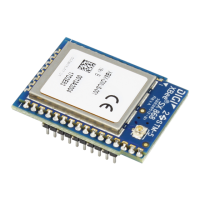Sleep modes Sleep coordinator sleep modes in the DigiMesh network
XBee® SX 868 RF Module User Guide
106
Auto-early wake-up sleep option
Similar to the sleep guard time, the auto early wake-up option decreases the sleep period based on
the number of sync messages a node misses. This option comes at the expense of battery life.
Use the SO command to disable auto-early wake-up sleep. This option is enabled by default.
Select sleep parameters
Choosing proper sleep parameters is vital to creating a robust sleep-enabled network with a desirable
battery life. To select sleep parameters that will be good for most applications, follow these steps:
1. Choose NH.
Based on the placement of the nodes in your network, select the appropriate values for
the NH (Network Hops) parameter .
We optimize the default values of NH to work for the majority of deployments. In most
cases, we suggest that you do not modify these parameters from their default values.
Decreasing these parameters for small networks can improve battery life, but take care
to not make the values too small.
2. Calculate the Sync Message Propagation Time (SMPT).
This is the maximum amount of time it takes for a sleep synchronization message to
propagate to every node in the network. You can estimate this number with the
following formula:
SMPT = NH*(MT+1)*18 ms.
3. Select the duty cycle you want.
4. Choose the sleep period and wake time.
The wake time must be long enough to transmit the desired data as well as the sync message.
The ST parameter automatically adjusts upwards to its minimum value when you change other
AT commands that affect it (SP, and NH).
Use a value larger than this minimum. If a device misses successive sync messages, it reduces
its available transmit time to compensate for possible clock drift. Budget a large enough ST
time to allow for the device to miss a few sync messages and still have time for normal data
transmissions.
Sleep immediate
In order to ensure that the needed messages have time to traverse the network, ST must be
sufficiently large. Additionally, your application is a factor in determining what ST should be. When
ST/SP increases, the batteries burn out faster. Yet, ST must be large enough for a functional network.
To mitigate this problem, the Sleep Immediate command is available (in version 0x9009 and newer).
The Sleep Immediate (SI) command can be sent by your application after it determines that all
needed transmissions are completed. This not only puts the node that issues the command asleep,
but it also sends a broadcast to put the whole network to sleep. The network will then remain asleep
for the remainder of the wake time and the subsequent sleep time. Then the entire network will
awaken again, resuming the same sleep cycle as before.
In the event that one or more nodes fail to receive the sleep immediate broadcast, they will not get
the power savings, but they will still remain synchronized to the network because the sleep cycle
would not have changed.

